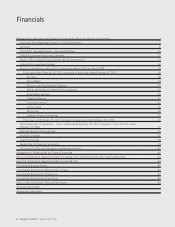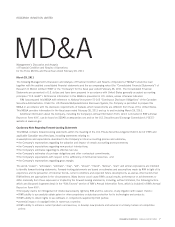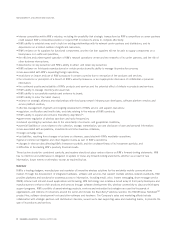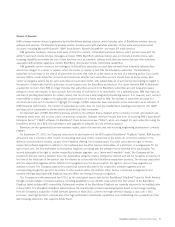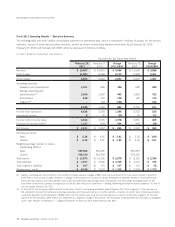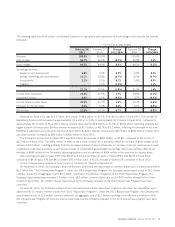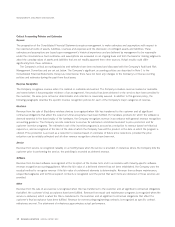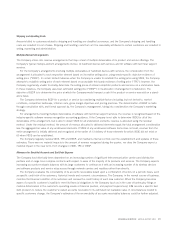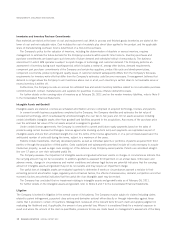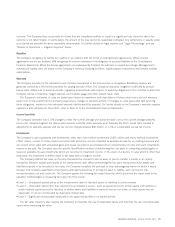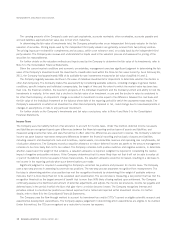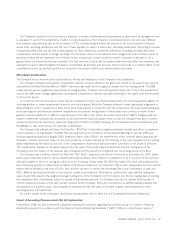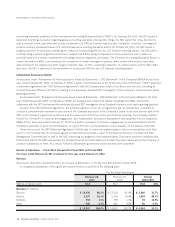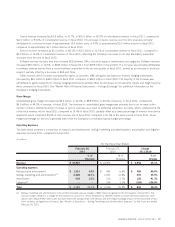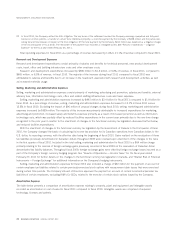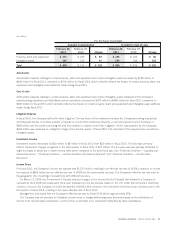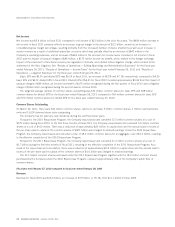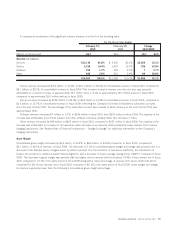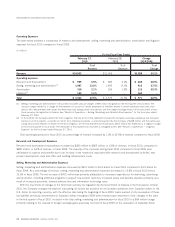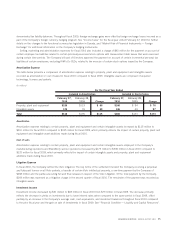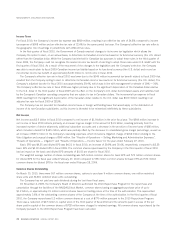Blackberry 2011 Annual Report Download - page 29
Download and view the complete annual report
Please find page 29 of the 2011 Blackberry annual report below. You can navigate through the pages in the report by either clicking on the pages listed below, or by using the keyword search tool below to find specific information within the annual report.The carrying amounts of the Company’s cash and cash equivalents, accounts receivable, other receivables, accounts payable and
accrued liabilities approximate fair value due to their short maturities.
In determining the fair value of investments held, the Company primarily relies on an independent third party valuator for the fair
valuation of securities. Pricing inputs used by the independent third party valuator are generally received from two primary vendors.
The pricing inputs are reviewed for completeness and accuracy, within a set tolerance level, on a daily basis by the independent third
party valuator. The Company also reviews and understands the inputs used in the valuation process and assesses the pricing of the
securities for reasonableness.
For further details on the valuation methods and inputs used by the Company to determine the fair value of its investments, refer to
Note 5 to the Consolidated Financial Statements.
Given the current market conditions and economic uncertainties, management exercises significant judgment in determining the fair
value of the Company’s investments and the investment’s classification level within the three-tier fair value hierarchy. As at February 26,
2011, the Company had approximately 96% of its available-for-sale investments measured at fair value classified in Level 2.
The Company regularly assesses declines in the value of individual investments for impairment to determine whether the decline is
other-than-temporary. The Company makes this assessment by considering available evidence, including changes in general market
conditions, specific industry and individual company data, the length of time and the extent to which the market value has been less
than cost, the financial condition, the near-term prospects of the individual investment and the Company’s intent and ability to hold the
investments to maturity. In the event that a decline in the fair value of an investment occurs and the decline in value is considered to
be other-than-temporary, an impairment charge is recorded in investment income equal to the difference between the cost basis and
the fair value of the individual investment at the balance sheet date of the reporting period for which the assessment was made. The
Company’s assessment on whether an investment is other-than-temporarily impaired or not, could change due to new developments or
changes in assumptions or risks to any particular investment.
For further details on the Company’s investments and fair value conclusions, refer to Note 4 and Note 5 to the Consolidated
Financial Statements.
Income Taxes
The Company uses the liability method of tax allocation to account for income taxes. Under this method, deferred income tax assets
and liabilities are recognized based upon differences between the financial reporting and tax bases of assets and liabilities, and
measured using enacted tax rates and laws that will be in effect when the differences are expected to reverse. The Company’s deferred
income tax asset balance represents temporary differences between the financial reporting and tax basis of assets and liabilities,
including research and development costs and incentives, capital assets, non-deductible reserves and operating loss carryforwards, net
of valuation allowances. The Company records a valuation allowance to reduce deferred income tax assets to the amount management
considers to be more likely than not to be realized. The Company considers both positive evidence and negative evidence, to determine
whether, based upon the weight of that evidence, a valuation allowance is required. Judgment is required in considering the relative
impact of negative and positive evidence. If the Company determines that it is more likely than not that it will not be able to realize all
or part of its deferred income tax assets in future fiscal periods, the valuation allowance would be increased, resulting in a decrease to
net income in the reporting periods when such determinations are made.
Significant judgment is required in evaluating the Company’s uncertain tax positions and provision for income taxes. The Company
uses a two-step process in assessing its uncertain tax positions. The two-step process separates recognition from measurement. The
first step is determining whether a tax position has met the recognition threshold by determining if the weight of available evidence
indicates that it is more likely than not to be sustained upon examination. The second step is measuring a tax position that has met the
recognition threshold as the largest amount of benefit that is more than 50% likely of being realized upon settlement. The Company
continually assesses the likelihood and amount of potential adjustments and adjusts the income tax provisions, income tax payable and
deferred taxes in the period in which the facts that give rise to a revision become known. The Company recognizes interest and
penalties related to uncertain tax positions as interest expense that is netted and reported within investment income. For further
details, refer to Note 8 to the Consolidated Financial Statements.
The Company uses the flow-through method to account for investment tax credits (“ITCs”) earned on eligible scientific research and
experimental development expenditures. The Company applies judgement in determining which expenditures are eligible to be claimed.
Under this method, the ITCs are recognized as a reduction to income tax expense.
16 RESEARCH IN MOTION ANNUAL REPORT 2011
MANAGEMENT’S DISCUSSION AND ANALYSIS


